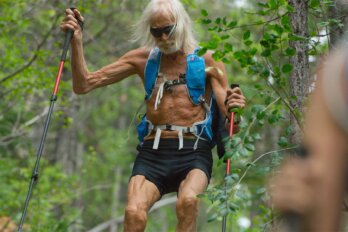The meals themselves didn’t seem that unusual. For breakfasts, Olympic race walker Evan Dunfee and his training partners would fill up on muesli with cream or bacon and eggs; lunches featured sandwiches with low-carb bread and lots of avocado; and dinners, specially prepared by the chefs at the Australian Institute of Sport and measured to the ounce for each athlete, ranged from almond satay or zucchini pasta to plain old pizza and burgers. This was the easy part of the diet. “Before and during training was where things got weird,” says Dunfee. Before a gruelling twenty-five-mile workout, he would fuel up with two boiled eggs and some nut balls: “nuts, cocoa, and I’m not sure what else to hold them together,” he recalls. “But they were all right.” For mid-workout fuelling, instead of gels and sports drink, it was peanut-butter cookies and cheese.
The diet was a radical departure for Dunfee, a twenty-five-year-old Canadian from Vancouver, and a risk—it was less than nine months before the 2016 Olympics in Rio, where he hoped to contend for a medal. But elite race walkers are…different. The event, which requires walking as quickly as possible while straightening your leg with each stride and keeping one foot on the ground at all times, is often the butt of jokes, both for its distinctive swivel-hipped stride and for its fundamental premise: NBC sports commentator Bob Costas famously compared it to a contest to see who can whisper the loudest. As a result, top race walkers from around the world form a notably cohesive clique. It meant that Dunfee was receptive when Australian walker Jared Tallent, the defending Olympic champion in the fifty-kilometre event, approached him about the possibility of skipping the boreal winter and instead flying south to train in Australia, where he would take part in an unprecedented study of a radical sports nutrition scheme that was generating buzz and controversy in equal measures: low-carbohydrate, high-fat, or “LCHF,” diets.
The LCHF debate, which has been roiling the weight-loss world since the early 2000s, had recently made the leap to endurance sport. At first, it was a few maverick scientists and would-be gurus, then some long-haired, dogma-defying ultra-runners, then, suddenly, Tim Noakes himself, author of the most influential running book of all time, embraced the cause with his customary fervour. “For 33 years I followed and advocated through my book, Lore of Running, the current dogma that to be active and healthy, one must eat a diet low in fat and high in carbohydrate,” he wrote in 2015. “I now believe that this advice was quite wrong. I apologize. It was an honest error.”
In Canberra, Dunfee and Tallent were joined by nineteen other world-class race walkers from five different continents for the LCHF study, code-named “Supernova.” While in residence at the AIS, the walkers followed a standardized training plan, and for periods of three weeks at a time, they adhered to strictly controlled diets that either followed conventional sports nutrition advice for endurance athletes (60 to 65 percent of calories from carbohydrate, 15 to 20 percent from protein, and 20 percent from fat) or an extreme LCHF diet (75 to 80 percent fat, 15 to 20 percent protein, and less than 50 grams per day of carbohydrate—the equivalent of two small bananas). Before and after the three-week diets, the athletes gave samples of blood and poop, completed a series of treadmill tests in the lab, and put their hard-earned fitness to the only test that really matters: a race.
For Dunfee, the transition to LCHF was rocky. In his first fully carb-free workout, what should have been an easy thirty-kilometre walk in two and a half hours turned into a “death march,” and he actually collapsed at the finish. Later that week, he set an all-time personal worst with his slowest ten-kilometre walk ever. Subsequent weeks went a little better, but his heart rate was consistently higher than usual during training, and so was his sense of effort. At the end of three weeks, lab testing showed that he was measurably less efficient, and he was slower in his ten-kilometre race. Overall, the results seemed disappointing. So it was with a palpable sense of relief that he resumed his standard high-carbohydrate diet. Almost immediately, he felt better and began crushing his workouts. Just ten days later, he headed to Melbourne for a race—where, to everyone’s surprise, he shattered the Canadian fifty-kilometre walk record with a time of 3:43:45, establishing himself as a podium contender for Rio.
When your car runs out of gas, it stops. In a very simplified sense, your body behaves in the same way. The fuel you use is supplied by food, which contains energy stored in the form of chemical bonds between atoms; those bonds are broken as the food is metabolized, releasing energy that powers your muscles and other organs. If you completely run out of food energy, of course, a bad race is the least of your worries. The records for longest survival without food are both grim and confusing, depending on the precise circumstances and the trustworthiness of the witnesses. A 1973 journal article by a Scottish doctor reports the case of A.B., a twenty-seven-year-old man who weighed 456 pounds before undertaking a medically supervised fast lasting 382 days, during which he lost a remarkable 276 pounds.
Such feats show that, no matter how badly you bonk during your Ironman, your gas tank isn’t truly empty. In fact, performance starts declining long before the needle hits E, for reasons that aren’t always obvious. In one study that launched a thousand maternal I-told-you-sos, British researchers found that skipping breakfast resulted in a 4.5 percent drop in thirty-minute cycling time trial performance at 5 p.m. that day, even though the subjects had been allowed to eat as much as they wanted at lunch. It’s not just how much fuel is in the tank, in other words. Endurance performance also depends on what types of fuel you have available, where it’s stored, and how quickly you can access it. The three basic types of fuel we have available are protein, carbohydrate, and fat. While protein is important for building and repairing muscles after resistance exercise, it plays a negligible role in directly fuelling muscle contractions. For the most part, though, carbohydrate and fat stoke the furnace during prolonged exercise—and their relative importance has been debated for more than a century.
Early experiments in the first half of the twentieth century showed that the balance between fat and carbohydrate use depends on how hard you’re working. During easy exercise, like a gentle walk, you burn mostly fat from the supplies circulating in your bloodstream. As you speed up, you begin to add more carbohydrate to the mix, and by the time you’re panting heavily, the proportions have flipped and you’re burning mostly carbohydrate. The precise blend depends on a variety of factors: the fitter you are, for example, the greater the proportion of fat you burn at any given speed. Eating a diet high in either fat or carbohydrate also tilts your preferred fuel mix in that direction. But even taking these factors into account, carbohydrates dominate for any intense exercise: one study found that over the marathon distance, running at 2:45 pace relied on 97 percent carbohydrate fuel, while slowing down to 3:45 pace reduced the carbohydrate mix to 68 percent.
The cliché of the pasta-fuelled marathoner can be traced back to the work of Swedish scientists Jonas Bergström and Eric Hultman in 1960s. Bergström pioneered the use of needle biopsies, a technique that allowed researchers to slice out small pieces of muscle from their long-suffering research volunteers—or, as was the habit in Scandinavian labs at the time, from their own muscles. In one notable study, Bergström and Hultman sat on opposite sides of a stationary bike, each pedalling with one leg while the other leg rested, until they were both too exhausted to continue. Self-inflicted muscle biopsies before and after cycling showed that levels of glycogen, the form in which carbohydrate is stored in muscles, had dropped to zero in the exercised leg. Running out of this specific muscle fuel, in other words, seemed to coincide with exhaustion. Over the next three days, the two men ate a high-carbohydrate diet and performed regular biopsies. Glycogen levels stayed roughly constant in their rested legs, but in the exercised legs, levels shot up to twice their initial value—a supercompensation effect that launched the idea of “carbohydrate loading” before long-distance races.
If that’s the case, then it makes sense for endurance athletes to stock up on carbohydrates as much as possible. And that, more or less, is what sports nutritionists have been advocating since the 1970s. Keep your glycogen levels high by consuming a diet that gets 60 to 65 percent of its calories from carbohydrate, top up your stores by carbo-loading in the final few days before a competition, and in events lasting longer than about ninety minutes, eat or drink some easily digested carbohydrates to supplement your stored glycogen, which will otherwise run out.
Empirically speaking, this advice seems to work pretty well. One study found that Kenyan runners, who currently hold sixty of the top 100 men’s marathon times in history, typically get 76.5 percent of their calories from carbohydrate, including 23 percent from ugali, a sticky and stomach-filling cornmeal porridge, and 20 percent from the copious spoonfuls of sugar they heap into their tea and porridge. Another thirty-five times on the top-100 list are held by Ethiopians; a similar study found that they get 64.3 percent of their calories from carbohydrate, with the biggest contribution from injera, a sourdough flatbread made from a local grain called teff. If there’s an alternative diet plan that’s better for endurance performance, no one has told the best endurance athletes in the world.
To judge from the polarized debate on internet forums and social-media networks, you might think you have to pick a side: you either burn fat or carbohydrate, and woe to you if you make the wrong choice. In reality, we all use both. And given the complementary strengths and weaknesses of the two options—carbohydrate as a fast fuel with limited storage capability, fat as an inexhaustible but rate-limited alternative, it makes sense to aim for what Louise Burke, of the Australian Institute of Sport, calls “metabolic flexibility,” by maximizing both fuel pathways. That, in effect, is what ultra-runners are aiming for when they add targeted carbohydrate use before and during key workouts and races, while keeping overall fat levels high. And a mirror image of that approach—a standard high-carbohydrate diet while starting a few workouts each week with deliberately depleted carbohydrate stores—is what Burke and many other researchers around the world pursued in the years after she pronounced the “nail in the coffin” for high-fat diets in 2006.
But as LCHF continued to gain currency among endurance athletes, Burke decided it was worth returning to the topic for a more rigorous test. The result was the Supernova mega-study, featuring a longer three-week period of fat adaptation and a much higher proportion of fat in the diet. That’s what brought Evan Dunfee and his fellow race walkers to Canberra in late 2015—because if any athletes on the Olympic program stand to benefit from LCHF, it should be them. The men’s fifty-kilometre race walk is among the longest events in the Olympics, with winning times just under four hours; also, the rules of sport forbid you from breaking into an all-out sprint, making the possible loss of high-end power less of a problem.
The Supernova results, which were published in 2017, confirmed that endurance athletes on a three-week high-fat diet became fat-burning machines to an extent few had imagined possible. By the end of a twenty-five-kilometre time trial at their expected fifty-kilometre race pace, the athletes were burning through 1.57 grams of fat per minute, which is two and a half times greater than the “normal” values seen in athletes eating a standard carbohydrate diet. That was the good news. The problem was that the fat-adapted athletes became less efficient, requiring more oxygen to sustain their race pace. If you’re out for a leisurely stroll, that’s no big deal, but if you’re running (or walking) a race at a pace that leaves you out of breath, anything that forces you to consume more oxygen is a liability. As a result, it was no surprise that the LCHF athletes ended up performing worse than the high-carbohydrate athletes in the Supernova study’s final and most important real-world test: a ten-kilometre race walk.
That’s bad news for would-be LCHF Olympians, but it’s still not the final nail in the coffin for the high-fat approach. After all, recreational ultra-endurance athletes may be more willing to accept an efficiency penalty in exchange for the freedom to refuel less frequently. The efficiency penalty may also be less pronounced at the slower paces sustainable in longer events, such as Ironman triathlons. And finally, there was the encouraging real-world performance of the athletes in the study in the weeks following their LCHF block: in addition to Dunfee’s national fifty-kilometre record, another walker from the study set an African record in the same race, and several others notched personal bests. At the Olympics later that summer, Dunfee earned minor celebrity status when he declined to appeal a ruling that left him in fourth place after the eventual bronze medallist, Japan’s Hirooki Arai, was first disqualified for bumping Dunfee in the last kilometre of the race, then subsequently reinstated. Dunfee left Rio without a medal but with yet another national record, international acclaim for his sportsmanship, and lingering curiosity about the delayed benefits of the LCHF diet.
Excerpted and adapted from Endure: Mind, Body, and the Curiously Elastic Limits of Human Performance by Alex Hutchinson. Copyright © 2018 by Alex Hutchinson. Reprinted by permission of William Morrow, an imprint of HarperCollins Publishers.





